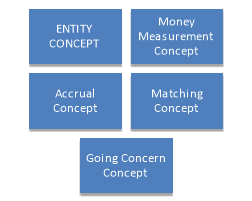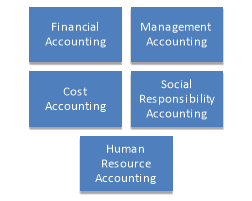Unit – 1
Basic Accounting concepts and conventions
Accounting concepts define the assumptions on the basis of which financial statements of a business entity are prepared.
Guide for selection of conventions or procedures where alternative exists.
Accounting conventions emerge out of accounting practices, commonly known as accounting principles, adopted by various organizations, over a period of time. Accounting conventions need not have universal application.
In this study material, the term ‘accounting concepts’, ‘accounting principles’ and ‘accounting conventions’ are interchangeably used.
These basic accounting concepts are as follows:


a) Entity Concept:
Entity concept states that business enterprise is a separate identity apart from its owner. Accountants should treat a business as distinct from its owner.
b) Money Measurement Concept:
As per this concept, only those transactions which can be measured in terms of money are recorded. Transactions and events that cannot be expressed in terms of money are not recorded in the business books. Measuring unit for money is taken as the currency of the ruling country.
c) Accrual Concept:
Under accrual concept, the effects of transactions are recognised on Mercantile basis i.e., when they occur and not when cash is received or paid and they are recorded in the accounting records of the periods to which they relate.
d) Matching Concept:
In this concept, all expenses matched with the revenue of that period should only be taken into consideration. In the financial statements of the organisation, if any revenue is recognised, then expenses related to earn that revenue should also be recognised.
e) Going Concern Concept:
The financial statements are normally prepared on the assumption that an enterprise is a Going Concern and will continue its operations for the foreseeable future. Hence it is assumed that the enterprise has neither the intention nor the need to liquidate the scale of its operations.
f) Cost Concept:
By this concept, the value of an asset is to be determined on the basis of Historical cost, in other words, Acquisition cost.
g) Dual Aspect Concept:
This concept is the core of double entry bookkeeping. Every transaction or event has two aspects.
If a transaction increases one asset, it decreases another asset or increases a liability. If it decreases one asset, it increases another asset or decreases a liability. Alternatively, if it increases one liability, it decreases another liability or increases an asset. If it decreases a liability, it increases another liability or decreases an asset.
h) Conservatism:
Conservatism states that the accountant should not anticipate an income and should provide for all possible losses. It is not prudent to count unrealized gain but it is desirable to guard against all possible losses.
i) Consistency:
In order to achieve comparability of the financial statements of an enterprise through time, the accounting policies are followed consistently from one period to another and a change in an accounting policy is made only in certain exceptional circumstances. An enterprise should change its accounting policy in any of the following circumstances only:
To bring the books of accounts in accordance with the issued accounting standards. To compliance with the provisions of law and when under changed circumstances, it is felt that new method will reflect more true and fair picture in the financial statement.
j) Materiality:
Materiality principle permits other concepts to be ignored if the effect is not considered material. The term material is a subjective term; it is on the judgement, common sense and discretion of the accountant that which item is material and which is not. The materiality depends not only upon the amount of the item but also upon the size of the business and its nature.
The various types of Accounting are:

Financial Accounting: Financial Accounting is a field of accounting that is concerned with summarizing, analysing and reporting of financial transactions of a business. It is historical in nature because the transactions which had already been occurred, are recorded.
Management Accounting: In simple terms, Management Accounting is defined as providing of financial as well as non-financial decision-making information to the managers of the business. Generally, it is not released publically as it is concerned with only the internal reporting to the managers of a business unit.
Cost Accounting: According to Harold Wheldon, "Costing is the classifying, recording and appropriate allocation of expenditure for the determination of cost". It can be understood from the definition that cost accounting relates to the classification and ascertainment of the cost of a product.
Social Responsibility Accounting: Social accounting is defined as the reporting of the costs incurred in various societal beneficial requirements and more generally, the impact that the business entity created on the society and the environment. Thus, it is concerned with the accounting of social costs incurred and social benefits created.
Human Resource Accounting: Human resource accounting is a process to identify the investments incurred to develop human resources of an organisation. Various costs are incurred by a business entity to recruit, select, train and develop the personnel so that they work effectively.
Besides, there are other various types of accounting. Public Accounting, Government Accounting, Forensic Accounting, Tax Accounting are some of them.
JOURNAL:
Every financial record, when entered for the first time in the books, it is recorded in the Journal Book. A Journal Book is regarded as the primary book of accounting records.
In Journal, the records are kept in a chronological order of dates. This process of recording the entries in Journal Book is a continuous process, which is done throughout the year.
The Journal Book is recorded on the basis of Double Entry System of Book-keeping. The two aspects of the transaction are determined, that is the Debit and Credit and accordingly a Journal Entry is passed by debiting a certain account and crediting another.
The proforma of Journal Entries is as follows:
Date | Particulars | L.F. | Debit (Rs.) | Credit (Rs.) |
2019 Apr 1 |
____________ A/c Dr. To ______________ A/c (Being _____________________________)
|
|
Xyz |
Xyz |
The word Journal has been derived from the French word Jour which means ‘of the day’. So the Journal Book means that accounting book which is maintained on a daily basis.
Every Journal Entry is followed by a narration (explanation); which begins with the word ‘Being’. It is a short explanation of the transaction and recorded with a view for future reference. Journal increases the efficiency in accounting tasks. The Journal also helps in rectification of errors, if any.
LEDGER:
Ledger is a book which contains multiple accounts in a summarised form prepared from the Journal Books. It includes accounts of various Incomes, Expenditures, Assets, Liabilities and the Capital Account. These accounts are recorded throughout the year.
The ledger is known as Principal Book of Accounting. Each Ledger is prepared in a chronological order of dates but it is more concerned with the arrangement of grouping of entries with similar affecting account within a ledger.
Each transaction is recorded in atleast two accounts. Every Ledger Account have two sides, Debit and Credit. The ledgers are prepared from Journal Entries and this process is known as Posting.
For example, if the Cash balance is increased due to a financial transaction, say Cash Sales, then the ledger of Cash, that is Cash Account is Debited, because Cash is a Real A/c and the Golden Rule of the same is ‘Debit what comes in’. On the other hand, the ledger of Sales, that is Sales Account is Credited, because Sales is a Nominal A/c and its rule is ‘Credit all Incomes and Gains’.
The Debit posting is at the left side of the account and the Credit posting is on the right side.
The proforma of Ledger Account is as follows:
_______________ A/c
Date | Particulars | J.F. | Amount (Rs.) | Date | Particulars | J.F. | Amount (Rs.) |
|
|
|
|
|
|
|
|
TRIAL BALANCE:
Preparation of Journal and Ledger is a continuous practise and a year-going process. On the other hand, at the end of the year, Trial Balance is prepared.
A Trial Balance is a summarized statement in which the closing balances of all ledgers are compiled in a single statement. The ledger accounts are totalled at the end of the financial year and balanced. The Balance is known as Closing Balance. These closing balances are posted to the statement of Trial Balance.
The proforma of Trial Balance is as follows:
Trial Balance as on ______________
Dr. Cr.
Particulars | Amount (Rs.) | Particulars | Amount (Rs.) |
|
|
|
|
OR
Particulars | Debit Amount (Rs.) | Credit Amount (Rs.) |
|
|
|
Trial Balance of the company serves to detect any mathematical errors that may have occurred while accounting. At the end of the accounting year, the ledgers of Assets, Expenses or Losses should have a Debit Balance while that of Liabilities, Incomes and Gains should have Credit Balance.
Final Accounts of an organisation shows the financial position of the business. Preparation of Final Accounts is the last step in the accounting process. At the end of the year, Final Accounts are prepared from Trial Balance. Final Accounts includes Trading Account, Profit and Loss Account and Balance Sheet.
All those accounts that are related to Factory (manufacturing activity) and Goods are posted to the Trading A/c, whereas all other accounts of Indirect Expenses and Indirect Incomes are posted to the Profit and Loss A/c. The accounts of all the Assets and Liabilities are posted to the Balance Sheet.
Section 209 to 220 of the Companies Act, 2013 deals with the legal provisions relating to preparation of Final Accounts.
Trading Account: A trading account shows the results of buying and selling of goods. According to J. R. Batliboi- “The Trading Account shows the result of buying and selling goods. In preparing this account, the general establishment charges are ignored and only the transactions in goods are included.”
Gross Profit or Loss is determined on preparing Trading Account.
Profit and Loss Account: It records the Indirect Expenses of a business firm, like Rent, Salaries, Advertising expenses, etc. and Indirect Incomes like Commission Received or Interest received. Profit and loss Account includes expenses and losses and income and gains, which has occurred in business other than the production of goods and services.
Net Profit or Loss is determined on preparing Profit and Loss Account.
Balance Sheet: The statement of Balance Sheet demonstrates the financial position of a business on a specific date, especially at the last date of the financial year. The excess of assets over liabilities represents the capital in the business and reflects the financial soundness of a company.
Books Recommended :
1. J. R. Batliboi —Advanced Accounts
2. M. C. Shukla —Advanced Accounts
3. S. M. Shukla —Advanced Accounts
4. Pickles —Advanced Accounts
5. N. K. Jha —Basic Financial Accounting
6. S. K. Singh & R.U. Singh —Financial Accounting